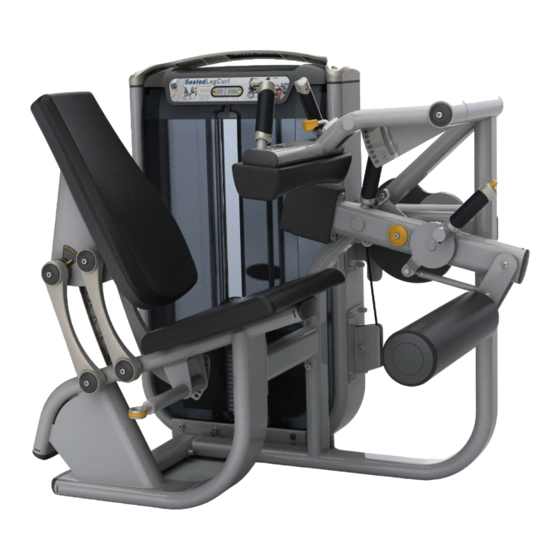Advertisement
Strength Cable and Belt Guide
Keeping strength cables and belts tensioned properly is not part of the product warranty and
should be maintained by the facility. This document will walk you through how to properly
tension Matrix strength cables and belts and, also show you examples of damaged cables.
Cables can stretch over their life and should be checked WEEKLY for proper tension and
inspected for damage. Without proper tension, users will lose some range of motion and excess
wear to the cables can occur.
Revised: March 2021 I Revised By: BNelson
Table of Contents
(click a link to be directed to that instruction)
Identifying Damaged Cables & Components
Page 1 of 15
Advertisement

Summary of Contents for Matrix Ultra Series
-
Page 1: Table Of Contents
This document will walk you through how to properly tension Matrix strength cables and belts and, also show you examples of damaged cables. Cables can stretch over their life and should be checked WEEKLY for proper tension and inspected for damage. -
Page 2: Cable Bolt Overview
Cable Bolt Overview Strength cables may have different size cable bolts that connect to the top plate or head plate adapter on weight stacks. For this reason, it is important to follow these steps when tensioning cables to ensure your cable has enough engagement to not be a safety concern. Remove and measure the cable bolt. -
Page 3: Checking For Proper Tension
Checking for Proper Tension Ultra, Versa, Aura, Go and Varsity Series Single Stations Check for Proper Tension: 1. Unpin the weight stack pin from the stack 2. From the midway point of the cable bolt and top of weight stack, use your finger to move the cable from side to side. -
Page 4: Ultra Series
If not, loosen the jam nut on the cable bolt and turn out 1 thread then recheck Note: Some 2018 and newer Ultra Series units may also have the top down tensioning shown for Versa Revised: March 2021 I Revised By: BNelson... -
Page 5: Versa Series
Versa Series Versa Series single stations use a ball end cable at the top of the weight stack. The cable is secured to the head plate by a jam nut locking it in place. To adjust the cable tension, you must use the adjustment on the lower part of the weight stack frame. -
Page 6: Aura Series
Aura Series The Aura Series was originally designed with a reinforced 15/16” flat Kevlar/urethane belt. Later, a line extension was designed using cables. Belts and cables are NOT interchangeable. Cables Important: A minimum of ½” (13mm) of the cable bolt must be engaged into the head plate adapter Cable Tensioning Procedure: 1. - Page 7 Aura Series The Aura Series was originally designed with a reinforced 15/16” flat Kevlar/urethane belt. Later, a line extension was designed using cables. Belts and cables are NOT interchangeable. Belts Belts should be tensioned if you notice the belt riding to one side of a pulley or if range of motion loose is seen.
-
Page 8: Go Series
Go Series Important: A minimum of ½” (13mm) of the cable bolt must be engaged into the head plate adapter Cable Tensioning Procedure: 1. Unpin the weight stack pin from the stack 2. Remove the cable bolt from the head plate adapter 3. -
Page 9: Varsity Series
Varsity Series Varsity Series machines have two different cable attachment assemblies. One assembly has a cable bolt that attaches to the head plate shown below. The second is a clamp style using a ball end cable (no bolt) shown on the next page. Important: A minimum of ½”... - Page 10 Varsity Series The machines using the cable clamp will have a ball end cable (above weight stack) with a cable stopper at the user end of the cable. The cable tension for these machines is based on the cable stopper position to the pulley.
-
Page 11: Cable Cross & Functional Trainers
Cable Cross and Functional Trainers Important: A minimum of ½” (13mm) of the cable bolt must be engaged into the adjustable pulley sleeve/pulley carriage. Cable Tensioning Procedure: 1. Remove the cable bolt 2. Turn down so ½” (13mm) of engagement is achieved 3. - Page 12 Identifying Damaged Cables It is important to check cable conditions weekly. If any of the following are noticed, please put the unit “out of order” and contact Matrix for a replacement cable. Fractures: Casing can crack or fracture under strains during use. Any crack in the casing merits cable replacement even if no wire rope is exposed.
- Page 13 Bent: Cable has ‘kink’ and prohibits cable from laying straight. Wire rope may be unraveling beneath casing and is compromised warranting replacement. Ends Separating: Watch for component end of cable to pull away from cable assembly - look for exposed wire rope.
- Page 14 Cable Protection Components Assembly Instructions 1. Slide the ball stop and then the strain relief onto the cable. The strain relief fits inside the ball stop and extends out the other side. 2. Place the cable end into the eyelet end fitting. Pull the ball up into the end fitting and line up the screw holes on the ball and fitting.
- Page 15 3. Apply Vibra-Tite thread locker (red) to the bolt. Next, use a 4mm Allen wrench to attach the socket head screw to secure the assembly. Revised: March 2021 I Revised By: BNelson Page 15 of 15...

















Need help?
Do you have a question about the Ultra Series and is the answer not in the manual?
Questions and answers